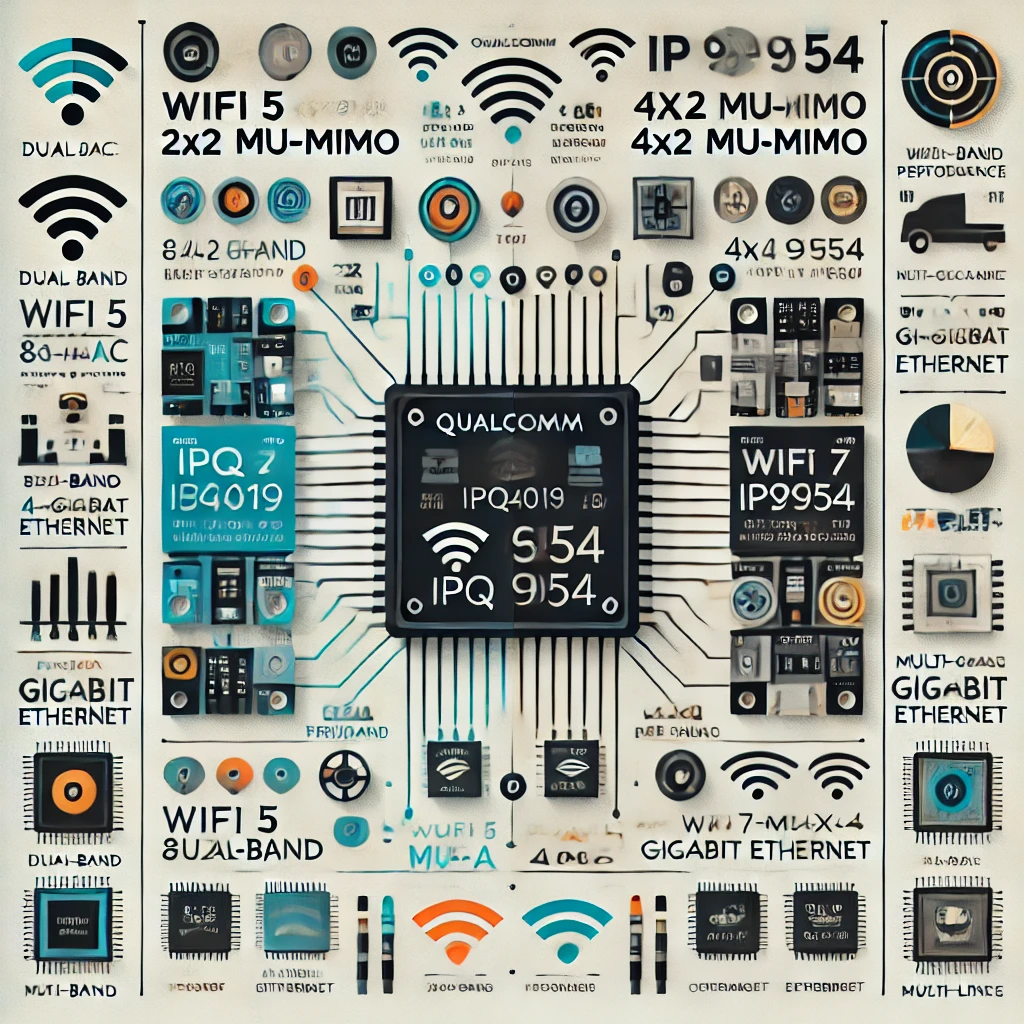IPQ4019 vs IPQ9554: Comprehensive Analysis of WiFi 5 and WiFi 7 Chipsets

As wireless networking technology advances, each generation of WiFi brings significant improvements in speed, capacity, and functionality. Qualcomm’s IPQ4019 and IPQ9554 represent two distinct eras of WiFi technology: WiFi 5 and WiFi 7, respectively. This article provides a detailed comparison of these two chipsets, highlighting their technical specifications, use cases, and evolutionary significance.
1. Overview of IPQ4019
The Qualcomm IPQ4019 is a versatile WiFi 5 (802.11ac) chipset designed for cost-effective routers, access points, and mesh networking solutions. It has been widely adopted in consumer and enterprise-grade networking devices due to its balance of performance and affordability.
Key Features:
WiFi Standard: WiFi 5 (802.11ac)
Frequency Bands: Dual-band (2.4 GHz and 5 GHz)
CPU: Quad-core ARM Cortex-A7 @ 717 MHz
Networking Support: 2x2 MU-MIMO for both 2.4 GHz and 5 GHz bands
Ethernet Support: Integrated 5-port Gigabit Ethernet switch
Additional Features: Support for mesh networking, MU-MIMO, and beamforming
Use Cases:
Affordable consumer-grade routers
Mesh networking systems
Small business wireless solutions
IPQ4019 delivers reliable performance for moderate bandwidth applications, such as video streaming, online gaming, and general internet usage, but lacks the advanced capabilities of newer WiFi generations.
2. Overview of IPQ9554
The Qualcomm IPQ9554 is a state-of-the-art WiFi 7 (802.11be) chipset designed for next-generation networking devices. It targets high-performance applications with its advanced features and superior processing capabilities.
Key Features:
WiFi Standard: WiFi 7 (802.11be)
Frequency Bands: Tri-band (2.4 GHz, 5 GHz, and 6 GHz)
CPU: Quad-core ARM Cortex-A73 @ 2.2 GHz
Networking Support: 4x4 MU-MIMO and 4K QAM for all bands
Ethernet Support: Multi-gigabit support (up to 10 Gbps Ethernet)
Advanced Features:
Multi-Link Operation (MLO) for simultaneous multi-band connectivity
320 MHz channel bandwidth for high throughput
Reduced latency for time-sensitive applications
Support for WiFi 7’s Enhanced Deterministic Networking
Use Cases:
High-end consumer and enterprise routers
Ultra-low latency applications (e.g., AR/VR, cloud gaming)
Dense environments requiring robust connectivity (e.g., stadiums, smart cities)
IPQ9554 represents the pinnacle of wireless technology, delivering unparalleled speed, reduced interference, and advanced networking features for demanding use cases.
3. Comparative Analysis
4. Evolutionary Significance
The transition from IPQ4019 to IPQ9554 exemplifies the leap in technology from WiFi 5 to WiFi 7. Key advancements include:
Higher Speeds: WiFi 7 achieves significantly higher data rates through wider channels and 4K QAM.
Lower Latency: Technologies like MLO and deterministic networking cater to latency-critical applications.
Enhanced Capacity: Tri-band support and advanced MU-MIMO allow for more simultaneous connections.
Future-Ready: WiFi 7’s features make it suitable for emerging technologies like IoT, AR/VR, and smart cities.
5. Conclusion
While the IPQ4019 remains a dependable choice for budget-friendly and moderate-performance networking solutions, the IPQ9554 sets the benchmark for cutting-edge wireless technology. As WiFi 7 adoption grows, devices powered by IPQ9554 will enable seamless, high-speed, and ultra-low-latency connectivity for modern digital ecosystems.










评论